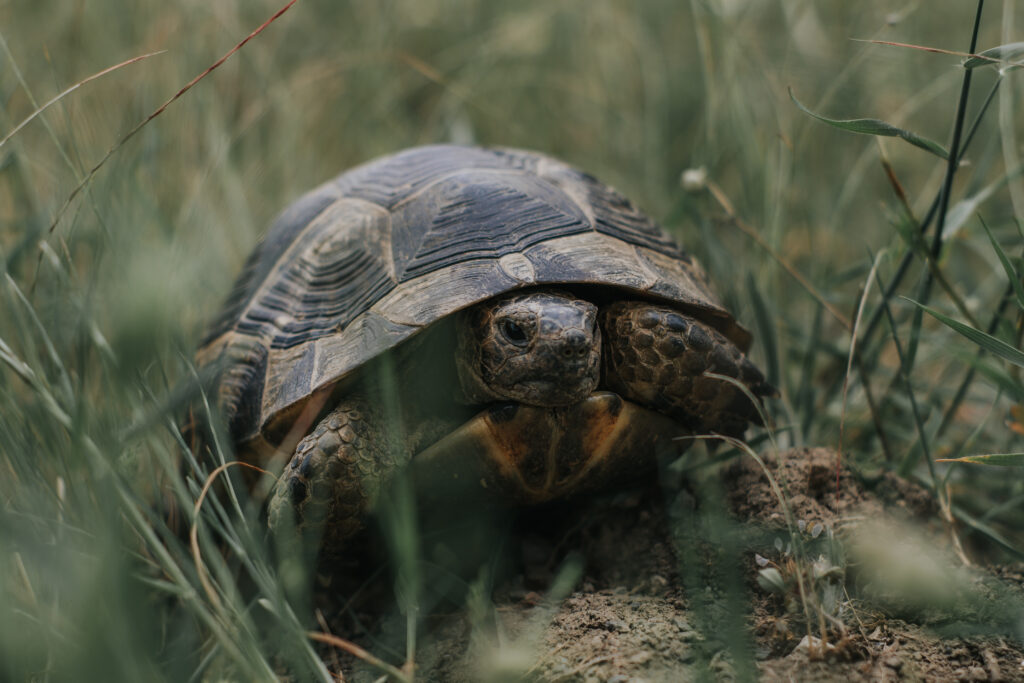
Image: Tortoise in Grass – Pexels
Snapping turtles and tortoises are two distinct species, but there are similarities that can cause confusion. Freshwater snapping turtles are native to North America, while tortoises inhabit regions across the globe. Nevertheless, these reptiles have diverse characteristics that set them apart.
Snapping turtles possess sharp beaks and powerful jaws for snatching prey. On the other hand, tortoises rely on their strong legs to traverse terrain. But they do share a common trait of having shells for protection.
Let’s take a closer look at the unique features of both species. By doing so, we can gain a deeper appreciation for these creatures and understand their individual roles in the ecosystem.
It’s time to explore the world of these fascinating reptiles! So dive in and uncover the secrets of snapping turtles and tortoises. Get ready to be amazed by all the amazing attributes they possess!
Key Takeaways
- No, a snapping turtle is not a tortoise. They belong to different families and have distinct characteristics.
- Snapping turtles are aquatic reptiles, while tortoises are land-dwelling reptiles.
- Snapping turtles have a more aggressive nature and are known for their powerful bite, while tortoises are generally docile creatures.
- The shell of a snapping turtle is more streamlined and adapted for swimming, whereas a tortoise’s shell is more dome-shaped and designed for protection on land.
- Snapping turtles have webbed feet and a long tail, which aid in their swimming abilities, while tortoises have sturdy, elephant-like legs for walking on land.
- Understanding the differences between snapping turtles and tortoises is important for proper care and handling of these reptiles.
Snapping Turtles

To understand snapping turtles, explore their description, habitat and behavior, and physical characteristics. Gain insights into what makes these reptiles unique and fascinating. Discover the distinctive features, the diverse habitats they inhabit, and their intriguing behaviors. Dive into the world of snapping turtles and unravel their captivating nature.
Description of Snapping Turtles
Snapping turtles are mysterious creatures. With big heads and strong jaws, they can snap their mouths shut with immense power. Their carapace is dark, which helps them to hide in their environment. They have long tails with scaly plates, perfect for swimming.
These turtles can live in both water and land. If needed, they can go on land for a long time. And, with proper care, they can live up to 100 years!
The National Geographic Society states that these creatures will eat anything – from fish and frogs to plants and small mammals.
Do they have a secret society? Maybe they use their karate skills there!
Habitat and Behavior of Snapping Turtles
Snapping turtles are fascinating creatures! They inhabit a variety of environments, from freshwater ponds to rivers. These turtles have strong jaws that deliver a powerful bite – which they use to defend themselves and catch prey.
Female turtles carefully select sites near water bodies to lay their eggs. They search for sandy or gravelly soil to bury and protect the eggs. This nesting behavior ensures the survival of the species.
To conserve snapping turtles, we must understand and respect their habitat. We must also avoid polluting water bodies, as this impacts their health. Creating awareness among local communities can help promote conservation efforts.
Let’s appreciate these intriguing creatures and their vital role in maintaining a balanced ecosystem. Together, we can create a harmonious environment where both humans and snapping turtles can thrive.
Physical Characteristics of Snapping Turtles
Snapping turtles possess some amazing traits. Let’s explore! They are big and have a strong bite. Their shells are usually dark brown or olive, helping them hide in their environment. They have sharp claws and a large head with a hooked jaw, which allows them to snap shut with great force.
Let’s look at a table to further understand the physical characteristics of snapping turtles:
| Characteristic | Description |
|---|---|
| Size | 18 inches in shell length max |
| Weight | 10 – 35 pounds average |
| Shell Color | Generally dark brown or olive |
| Limbs | Strong with sharp claws |
| Head | Large with powerful jaw |
Moreover, they have a keen sense of smell and use “turtlescrium” to attract their prey. Snapping turtles also have one of the strongest bites among all reptiles. Studies show that they can reach up to 1,000 pounds of pressure per square inch! Be warned, though: don’t underestimate their bite force or their sense of humor!
Tortoises
To gain a better understanding of tortoises, delve into their world. Learn about the fascinating physical characteristics, the unique habitat and behavior, and get a detailed description of these reptiles. Discover the wonders of tortoises and explore their captivating world with this comprehensive exploration.
Description of Tortoises
Tortoises have long been fascinating to scientists and enthusiasts alike. They have hard shells made of bone and keratin, and a unique pattern of shapes on each individual’s shell. They’re known for their remarkable longevity – some species can live up to 150 years!
Tortoises are known for their cautious, slow movements and their herbivorous diet. To keep them healthy, they need a spacious enclosure with suitable hiding spots and proper substrate. Offer them a varied diet with leafy greens and calcium supplements. Structures like logs and rocks can help enrich their environment. And regular veterinary check-ups can help detect potential health issues.
By taking these steps, we can help tortoises thrive in their natural habitat – and avoid any social gatherings!
Habitat and Behavior of Tortoises
Tortoises are quite the intriguing species! They have the ability to adapt to different environments, from rainforests to deserts. Plus, their slow and steady movements show off their calm and patient nature.
These herbivores usually feed on grass, leaves, fruits, and cacti. They use a strong jaw and beak-like mouth to chew tough vegetation. As cold-blooded reptiles, they need external heat sources to keep their temperature up. That’s why they often bask in the sun or seek shelter.
Tortoises can also protect themselves by retracting their heads and limbs into their shells. This serves as a defense against predators. Male tortoises have fascinating courtship rituals, such as head bobbing, chin rubbing, and shell bumping.
In the past, people believed that tortoises symbolized strength and resilience. Egyptians thought the world was supported by four giant tortoises standing on the back of a celestial turtle. Native American tribes also revered these creatures for their longevity and wisdom.
All in all, tortoises offer us a great view into the wonders of nature. Their ability to live in various places, plus their special behaviors, make them truly amazing!
Physical Characteristics of Tortoises
Tortoises astonish us with their grand physical features. Let’s take a closer look. Their shells are rugged and serve to protect them. Shell pattern variations range from domed to saddle-shaped. Plus, their spinal column supports their weight and brings stability.
Their heads come in different sizes and shapes. They have beak-like jaws for chewing vegetation and foraging.
Tortoises have strong and stocky limbs, which they can retract when threatened. This makes them resilient.
A Pro Tip: Notice the nuances like shell coloration and leg scales to distinguish between species.
We gain a deeper appreciation of these creatures by exploring their physical features. Mother Nature created them exquisitely. Tortoises have mastered the art of longevity with their ‘slow and steady’ lifestyle.
Comparison between Snapping Turtles and Tortoises

To better understand the distinctions between snapping turtles and tortoises, delve into the section comparing these two creatures. Explore the differences in appearance, habitat and behavior, as well as physical characteristics. Discover how each sub-section provides unique insights that help distinguish these two reptiles.
Differences in Appearance
Snapping turtles and tortoises are two distinct reptile species. Their looks differ significantly, highlighting diverse features that set them apart.
Snapping turtles have a large, rugged shell with sharp edges that offer protection from predators. Tortoises’ carapaces are dome-shaped, aiding in shielding them from threats.
Size-wise, snapping turtles are larger and heavier than tortoises. They can reach 20 inches in length and weigh up to 35 pounds, while tortoises measure around 16 inches and weigh about 15 pounds.
The shells of snapping turtles are dark brown or black with rough textures, perfect for blending in underwater. Tortoises’ shells are more vibrant with patterns and colors, allowing them to blend into their preferred land habitats.
Both have unique facial expressions. Snapping turtles have hooked beaks and powerful jaws that can deliver painful bites. Tortoises have rounded mouths with downward-pointing lips, made for nibbling vegetation.
These different traits evolved over millions of years, due to different ecological demands in each species’ habitat.
To sum up, though both reptiles, snapping turtles and tortoises have many distinctions when it comes to their looks. From shells to sizes, colors to facial expressions, these differences show the amazing diversity in the reptile world.
Differences in Habitat and Behavior
Snapping turtles and tortoises have contrasting habits and features. Let’s take a look at a table for more details:
| Snapping Turtles | Tortoises |
|---|---|
| Primarily aquatic | Terrestrial creatures |
| Found in freshwater | Often reside in dry, arid regions |
| Agile swimmers | Slower movements due to their shell weight |
| Can be aggressive | Peaceful demeanor |
Snapping turtles have powerful jaws that they can use to snap at threats. Tortoises, however, have shells that protect them and let them withstand tough conditions.
It’s interesting to note that snapping turtles are native to North America and have adapted to many environments. This proves their resilience as ancient reptiles.
Now we can see the differences between snapping turtles and tortoises in their habitats and behavior. Snapping turtles may have a fierce bite, but when it comes to physical features, tortoises take the lead with their protective shells.
Differences in Physical Characteristics
Snapping turtles and tortoises differ in physical features. Let’s take a look!
The table below compares their characteristics:
| Snapping Turtles: | Tortoises: |
|---|---|
| Convex shell, webbed front feet and strong, beak-like jaws. | Dome-shaped shell, elephantine hind legs and short and sturdy beaks. |
Moreover, snapping turtles have powerful jaws which make them capable of delivering forceful bites. Tortoises, however, have shorter but sturdy beaks for chewing vegetation.
Did you know that snapping turtles are part of the Chelydridae family? This is confirmed by the National Geographic Society.
Exploring the physical disparities between snapping turtles and tortoises clarifies their unique features. Hence, when deciding on either a snapping turtle or a tortoise, beware of its potential to snap fingers!
Frequently Asked Questions
1. Is a snapping turtle a tortoise?
Answer: No, a snapping turtle is not a tortoise. They belong to different families and have distinct characteristics. Snapping turtles are part of the Chelydridae family, while tortoises belong to the Testudinidae family.
2. What are the main differences between snapping turtles and tortoises?
Answer: Snapping turtles have a more streamlined and aggressive appearance, with sharp beaks, powerful jaws, and long tails. Tortoises, on the other hand, have dome-shaped shells, short and sturdy limbs, and are herbivorous.
3. Can snapping turtles retract into their shells like tortoises?
Answer: No, snapping turtles cannot retract into their shells like tortoises. They have a large bony shell, but their neck and limbs cannot be completely hidden within it. Tortoises, however, are known for retracting their head, legs, and tail into their shell for protection.
4. Do snapping turtles and tortoises have similar habitats?
Answer: Not exactly. Snapping turtles prefer freshwater habitats like ponds, swamps, and rivers. They are often found basking on logs or muddy banks. Tortoises, on the other hand, inhabit terrestrial environments, such as grasslands, deserts, and forests.
5. Do snapping turtles and tortoises have similar diets?
Answer: No, their diets differ. Snapping turtles have a varied diet and are opportunistic predators, feeding on fish, insects, amphibians, and even small mammals. Tortoises are herbivores and mainly consume plants, grasses, and fruits.
6. Can snapping turtles and tortoises be kept as pets?
Answer: Yes, both snapping turtles and tortoises can be kept as pets, but they require specialized care. Snapping turtles need large enclosures with access to water and a balanced diet. Tortoises need proper heat, lighting, and a suitable habitat to thrive.
Conclusion
Snapping turtles and tortoises may look alike but are in fact from different families. Chelydridae is the family of the snapping turtle, whereas the tortoise is part of the Testudinidae family. Snapping turtles tend to be more aggressive when compared to a tortoise. Furthermore, the habitats of these two species vary greatly. Snapping turtles prefer freshwater habitats while tortoises prefer dry land. These details demonstrate the clear differences between them.
It is interesting to note that through the ages, people have mistaken snapping turtles for tortoises. This was due to their hard shells and sluggish movements. But over time, scientific investigations have helped to differentiate between these two species. This anecdote highlights the importance of correctly identifying animals for better understanding and preservation.
References




